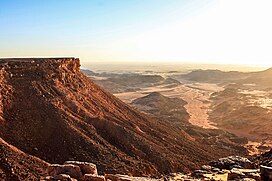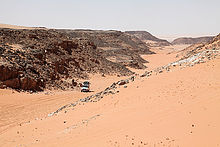Gilf Kebir
| Gilf Kebir | |
|---|---|
 View from the top of Gilf Kebir overlooking Wadi Sura | |
| Highest point | |
| Elevation | 1,014 to 1,016 m (3,327 to 3,333 ft) |
| Coordinates | 23°26′29″N 25°50′23″E / 23.44139°N 25.83972°E |
| Geography | |
| Country | Egypt |
Gilf Kebir (جلف كبير) (var. Gilf al-Kebir, Jilf al Kabir, Gilf Kebir Plateau) is a plateau in the New Valley Governorate of the remote southwest corner of Egypt, and southeast Libya. Its name translates as "the Great Barrier". This 7,770 km2 (3,000 sq mi) sandstone plateau, roughly the size of Puerto Rico, rises 300 m (980 ft) from the Libyan Desert floor. It is the true heart of the Gilf Kebir National Park.
The name Gilf Kebir was given to the plateau by
Geography and climate
The
.Wadis
The plateau is crisscrossed by Wadis (dry, seasonal riverbeds). These include:
- Wadi Hamra وادي حمرا
- Wadi Akhdar وادى الاخضر
- Wadi Bakht وادى بخت
- Wadi Dayiq وادى الضيق
- Wadi Firaq وادى فراق
- Wadi Gazayir وادى الجزائر
- Wadi Maftuh وادى مفتوح
- Wadi Mashi وادى ماشى
- Wadi Sura وادي صورة
- Wadi Wassa وادى واسع
- Wadi Abd el-Malik وادي عبد المالك
Climate
Gilf Kebir Plateau lies in the heart of the eastern part of the vast
| Climate data for Gilf Kebir Plateau | |||||||||||||
|---|---|---|---|---|---|---|---|---|---|---|---|---|---|
| Month | Jan | Feb | Mar | Apr | May | Jun | Jul | Aug | Sep | Oct | Nov | Dec | Year |
| Mean daily maximum °C (°F) | 20.8 (69.4) |
23.6 (74.5) |
27.8 (82.0) |
33.8 (92.8) |
36.6 (97.9) |
38.3 (100.9) |
38.7 (101.7) |
38.6 (101.5) |
37.2 (99.0) |
32.3 (90.1) |
26.3 (79.3) |
22.1 (71.8) |
31.3 (88.4) |
| Mean daily minimum °C (°F) | 7.7 (45.9) |
10 (50) |
12.4 (54.3) |
18.4 (65.1) |
22.2 (72.0) |
24.9 (76.8) |
26.1 (79.0) |
26.3 (79.3) |
24.2 (75.6) |
19.2 (66.6) |
13.2 (55.8) |
8.7 (47.7) |
17.8 (64.0) |
| Source: Storm247.com[3] | |||||||||||||
History
Petroglyphs

The Gilf Kebir is known for its prehistoric Neolithic petroglyphs
- Rock engravings in the upper part of wadi Hamra.
- Magharet el Kantara in the southern Gilf Kebir contains only one known rock art site, a cave discovered by Shaw & party in 1936.
- Wadi Sura in the southwestern Gilf Kebir: the "Cave of Swimmers", discovered by the Hungarian Count László Almásy (The English Patient), plus many other paintings nearby.
- In January 2003, Zerzura Expeditions and Jacopo Foggini independently discovered a major new rock art site in the Western Gilf Kebir (Foggini-Mestekawi Cave).
- The North-western half of the Gilf Kebir aside from Wadi Sura has only a few scattered engravings, of an apparently very ancient age.
- Karkur Talh and Karkur Murr: major eastern valleys of the Uweinat contain one of the richest concentrations of rock art in the whole Sahara.
- Western Uweinat: Shelters under the huge granite boulders in the western Uweinat contain numerous paintings, including the famous sites of Ain Doua.
- Jebel Arkenu, Jebel Kissu & Yerguehda Hill, the lesser granite massifs around Uweinat have many smaller sites.
Saharan rock art has been found to resemble the art of Nile valleys. The Saharan area was wetter until mid-Holocene or about 4000 BC, when the monsoon retreated southwards, forcing humans to migrate. Some retreated eastward to the Nile valley, taking with them their beliefs and influencing Egyptian art.[4][5][6]
20th century exploration

The hills of the Gilf Kebir were first seen from a distance by European explorers in 1910 - with W. J. Harding-King in 1910 and 1911, and Ball and Lieutenant Moore in 1918. The high southern part of the plateau was sighted for the first time by Prince Kamal el Dine Hussein in 1925, and on another expedition, in the following year, he fixed the eastern escarpment of the plateau and first realised the true size of the plateau. In 1930 an expedition headed by
The western side of the Gilf Kebir was explored in 1932 by the Clayton-Almásy Expedition, headed by Sir Robert East Clayton and Count László E. Almásy, and accompanied by Patrick A. Clayton, Squadron Leader H. W. G. J. Penderel, three Arabian car drivers and a cook. The expedition explored the area by Gypsy Moth plane, by car, and on foot.
1933 Patrick Clayton and Ladislaus Almasy discovered the Aqaba-Pass, the only way up Gilf Kebir from the southern plains i.e. from wadi Sura.[7]
WWII archeology
The plateau was the site for various British logistical operations during the
It was also the site of the 2007 discovery of a bag that had been lost in the
Literary setting
The Gilf Kebir is the setting for part of Michael Ondaatje's novel The English Patient. It also plays an important role in Paul Sussman's The Hidden Oasis.
See also
References
- ^ F. J. R. R., "A Reconnaissance of the Gilf Kebir by the Late Sir Robert Clayton East Clayton" and P. A. Clayton, "The Western Side of the Gilf Kebir" Geographical Journal 81, 249-254 and 254-259, (1933)
- ISBN 9781843530503.
- ^ "Weather for Gilf Kebir Plateau, Egypt". Storm247.com. Archived from the original on 24 December 2013. Retrieved 22 June 2013.
- ^ Jean-Loïc Le Quellec and Pauline and Philippe de Flers (2006). "Prehistoric swimmers in the Sahara." Arts & Culture 46-61.
- ^ Julien d'Huy (2009). "New evidence for a closeness between the Abu Ra´s shelter (Eastern Sahara) and Egyptian beliefs." Sahara 20: 125-126 and Julien d'Huy and Jean-Loïc Le Quellec (2009)
- ^ Julien d'Huy and Jean-Loïc Le Quellec (2009)"From the Sahara to the Nile: the low representation of dangerous animals in the rock art of the Libyan desert could be linked to the fear of their animation", or [1] Archived 2011-08-11 at the Wayback Machine, translation by Geoffrey Kolbe from "Du Sahara au Nil. La faible représentation d'animaux dangereux dans l'art rupestre du désert Libyque pourrait être lié à la crainte de leur représentation." Cahiers de l'AARS 13: 85-98, or [2].
- ^ Exploration and mapping of Gilf Kebir retrieved 16 April 2020
- ^ "WWII Army Bag Is Found In Desert". The BBC. The British Broadcasting Company. Retrieved 12 January 2023.
External links
- Legends haunt remote nomad's land, Matthew Davis, BBC. 25 September 2008.
- 'WWII Army Bag is found in Desert'
- Libyan Rock Art Documentation Project
- google map
- Gilf Kebir - Cave of Swimmers

